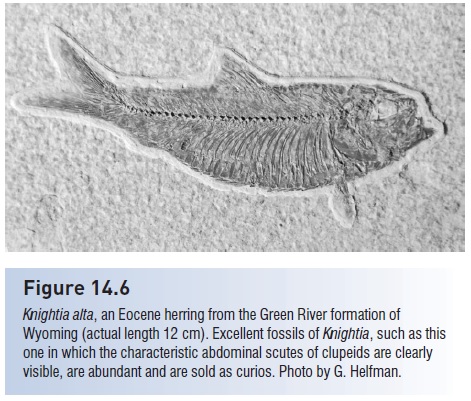Chapter: The Diversity of Fishes: Biology, Evolution, and Ecology: Teleosts at last I: bonytongues through anglerfishes
Subdivision Otocephala (= Ostarioclupeomorpha), Superorder Clupeomorpha - teleostean fishes
Subdivision Otocephala (= Ostarioclupeomorpha), Superorder Clupeomorpha
The past decade has seen considerable reanalysis of relationships among teleosts more advanced than the two primitive subdivisions of bonytongues and tarpon/eels. It is now widely agreed that herrings and minnowlike fishes, earlier separated, belong in the same subdivision, the Otocephala (or its tongue-twisting but descriptive synonym Ostarioclupeomorpha) (Johnson & Patterson 1996; Arratia 1997).
Among the most abundant and commercially important of the world’s fishes are the herringlike clupeiforms; large fisheries exist (or existed) for California Sardines, Peruvian Anchoveta, Atlantic and Gulf Menhaden, Atlantic Herring, and South African Sardine and Anchovy (Hutchings 2000a, 2000b; Hilborn 2005). Almost all are open water, pelagic, schooling forms, 80% of which are marine. Clupeomorphs are distinguished by a gas bladder that extends anteriorly up into the braincase and contacts the utriculus of the inner ear and in some extends posteriorly to the anus; the air bladder also has extensions to the lateral line canals. This otophysic (“ear-to-gas-bladder”) condition apparently increases the hearing ability of these fishes by increasing their sensitivity to low-frequency (1–1000 Hz) sounds as compared to other fishes. Low-frequency sounds of 3– 20 Hz are typically those produced by tail beats of other fishes, such as neighbors in a school and attacking predators (Blaxter & Hunter 1982). Clupeomorphs also typically possess a series of sharp, bony scutes along their ventral edge and some also have scutes anterior to the dorsal fin. These scutes may make these fishes harder for predators to capture and swallow, although direct proof is lacking. Of phylogenetic signifi cance, the superorder Clupeomorpha (modern clupeiforms and extinct, related orders) possess evolutionary advances over elopomorphs in terms of a modified joint at the posterior angle of the jaw (angular fused to articular rather than to retroarticular) and caudal skeleton reduction (reduced first ural centrum and reduction to six in number of hypural bones). These derived traits foreshadow the continued changes in jaw and tail structures that occurred during the evolution of higher teleostean groups.
The engraulid anchovies are relatively elongate zooplanktivorous clupeoids with large mouths made possible by an elongate maxillary that extends considerably behind the eye. Anchovies range in size from a minute Brazilian species (Amazonsprattus, 2 cm) to a piscivorous riverine New Guinea anchovy (Thryssa scratchleyi, 37 cm). The largest clupeids are the chirocentrid wolf herrings,Chirocentris dorab and C. nudus, with an Indo-Pacific to South Africa distribution. Wolf herrings are herrings gone mad. They reach a length of 1 m (the next largest clupeoid is a 60 cm Indian clupeid) and have fanglike jaw teeth plus smaller teeth on the tongue and palate which they use to capture other fishes.
The largest family in the superorder is the Clupeidae, which includes 188 species of herrings, round herrings, shads, alewives, sprats, sardines, pilchards, and menhadens. Clupeids can be marine, fresh water, or anadromous, with landlocked forms common (e.g., anadromous shads, alewives, and herrings have become established in lakes and reservoirs and in rivers trapped between dams). Whereas herrings, sardines, and menhaden are important commercially, some of the larger shads are popular sportfish (e.g., the American Shad, Alosa sapidissima; McPhee 2002).Probably the best known fish fossil in the world is †Knightia, a freshwater Eocene herring from the Green River shale formations of Wyoming (Fig. 14.6).

Figure 14.6
Knightia alta, an Eocene herring from the Green River formation of Wyoming (actual length 12 cm). Excellent fossils of Knightia, such as this one in which the characteristic abdominal scutes of clupeids are clearly visible, are abundant and are sold as curios. Photo by G. Helfman.
Related Topics